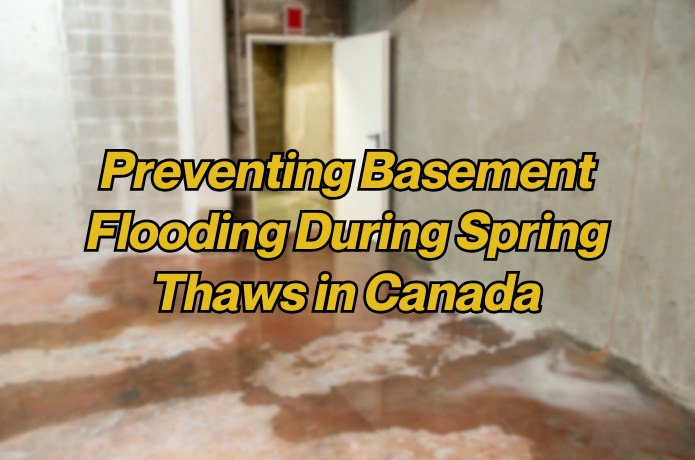Preventing Basement Flooding During Spring Thaws in Canada
Preventing Basement Flooding During Spring Thaws in Canada

As the winter season comes to an end, many Canadians experience the annual spring thaw, where melting snow and ice create an increase in water runoff. While this can signal the start of warmer weather, it also presents the risk of basement flooding. Homeowners across the country know that a basement flood can cause significant damage to the structure of a house and ruin valuable personal belongings. To avoid these costly issues, it is crucial to take preventative measures that protect your basement from water damage during the spring thaw.
Basement flooding is a common problem in areas that experience heavy snowfalls and cold winters, and the risk becomes more pronounced when the snow starts melting rapidly. If not properly managed, the water from the melting snow can find its way into the basement, causing leaks, mold growth, and structural damage. In this article, we will explore practical steps to prevent basement flooding during spring thaws in Canada, helping homeowners safeguard their homes from the damaging effects of excess water. From ensuring proper drainage to checking foundation seals, we’ll discuss key actions to take to protect your home.
Understanding the Causes of Basement Flooding During Spring Thaws
Basement flooding in Canada is often caused by the rapid melting of snow and ice during the spring thaw. When snow melts too quickly, the volume of water can overwhelm drainage systems that are not equipped to handle the excess runoff. This leads to water pooling around the foundation of the home, where it can seep into the basement through cracks in the walls or floor. Additionally, ice buildup in gutters and downspouts can block water flow, causing it to back up and spill over, adding to the risk of flooding.
Another significant factor contributing to basement flooding is the condition of the soil around your home. During the winter, soil can become compacted and frozen, making it harder for water to be absorbed into the ground. As the temperature rises and the snow melts, the water has nowhere to go but towards your home’s foundation. If your home is built in an area prone to high water tables or poor drainage, the risk of basement flooding becomes even more significant. Understanding these causes is the first step in taking the right actions to prevent flooding during the spring thaw.
Inspect and Clean Gutters and Downspouts
One of the most effective ways to prevent basement flooding is to ensure that your gutters and downspouts are clean and in good working condition. Over the winter months, debris such as leaves, twigs, and even ice can accumulate in your gutters, blocking the flow of water during the spring thaw. If the gutters are clogged, the water will spill over the sides, flowing towards the foundation of your home rather than being directed away from it.
To prevent this, clean your gutters thoroughly before the spring thaw begins. Ensure that the downspouts are free of obstructions and that they are directing water at least 3-4 feet away from the foundation. In some cases, you may need to extend your downspouts further to prevent water from pooling near the foundation. If your gutters and downspouts are damaged, consider repairing or replacing them to ensure they function properly during the spring thaw.
Properly Grade Your Yard to Direct Water Away from the Foundation
The grading of your yard plays an essential role in preventing basement flooding. If the ground around your home slopes toward the foundation, water from the melting snow will naturally flow toward the house, increasing the risk of water seepage into the basement. To avoid this, ensure that your yard is graded properly, with the ground sloping away from the foundation at a slight angle.
You can improve your yard’s grading by adding soil or mulch around the foundation to create a slope that directs water away. Additionally, you can install a French drain or a dry well in areas where water tends to accumulate. These systems are designed to redirect water away from the foundation and prevent it from pooling around the basement. Regularly checking the grading of your yard can help ensure that water is being directed in the right direction and reducing the risk of flooding.
Seal Cracks and Gaps in the Foundation
Cracks or gaps in the foundation are common entry points for water to seep into your basement. Over time, the freezing and thawing cycles of the winter months can cause small cracks to form in the foundation walls or floor. During the spring thaw, the melting snow can take advantage of these cracks, allowing water to enter your basement and cause flooding.
Before the spring thaw begins, inspect the foundation of your home for any visible cracks or gaps. Use a waterproof sealant or masonry caulk to fill in any cracks that you find. For larger cracks or more severe damage, it may be necessary to hire a professional to repair the foundation and ensure that it is properly sealed. Regular maintenance and prompt repairs can help prevent water from entering your basement during the spring thaw.
Install a Sump Pump for Added Protection
A sump pump is a valuable tool for protecting your basement from flooding. This device is designed to pump water out of your basement if the water level rises above a certain point. Sump pumps are particularly useful in areas with high water tables or where the ground has poor drainage. By installing a sump pump, you can ensure that any water that does enter your basement is quickly removed before it has a chance to cause significant damage.
When installing a sump pump, make sure to place it in the lowest part of your basement and ensure that it is connected to a discharge pipe that directs water away from the foundation. It’s also essential to test your sump pump before the spring thaw to ensure it is functioning properly. If your sump pump is old or not working correctly, consider replacing it with a newer model that is more efficient and reliable.
Maintain Landscaping Features to Prevent Water Accumulation
Landscaping around your home can also impact how water flows during the spring thaw. Certain landscaping features, such as flower beds, shrubs, and trees, can trap water near the foundation if not properly maintained. To reduce the risk of flooding, ensure that your landscaping features are designed to direct water away from the house.
Trim back any overgrown bushes or trees that may block drainage paths, and consider installing a rain garden or other water-friendly features that can help absorb excess water. Avoid creating berms or mounds of soil near the foundation, as these can direct water toward the house instead of away from it. By maintaining your landscaping, you can help manage the flow of water and protect your basement from flooding.
Preventing basement flooding during spring thaws in Canada requires proactive steps to manage water runoff and protect your home’s foundation. By cleaning and maintaining gutters, grading your yard, sealing foundation cracks, and installing a sump pump, you can reduce the risk of water entering your basement. Additionally, proper landscaping and regular inspections can ensure that water is directed away from your home, further preventing flooding. With these simple but effective measures, you can safeguard your basement from the damaging effects of spring thaw and ensure your home remains dry and secure throughout the season.

